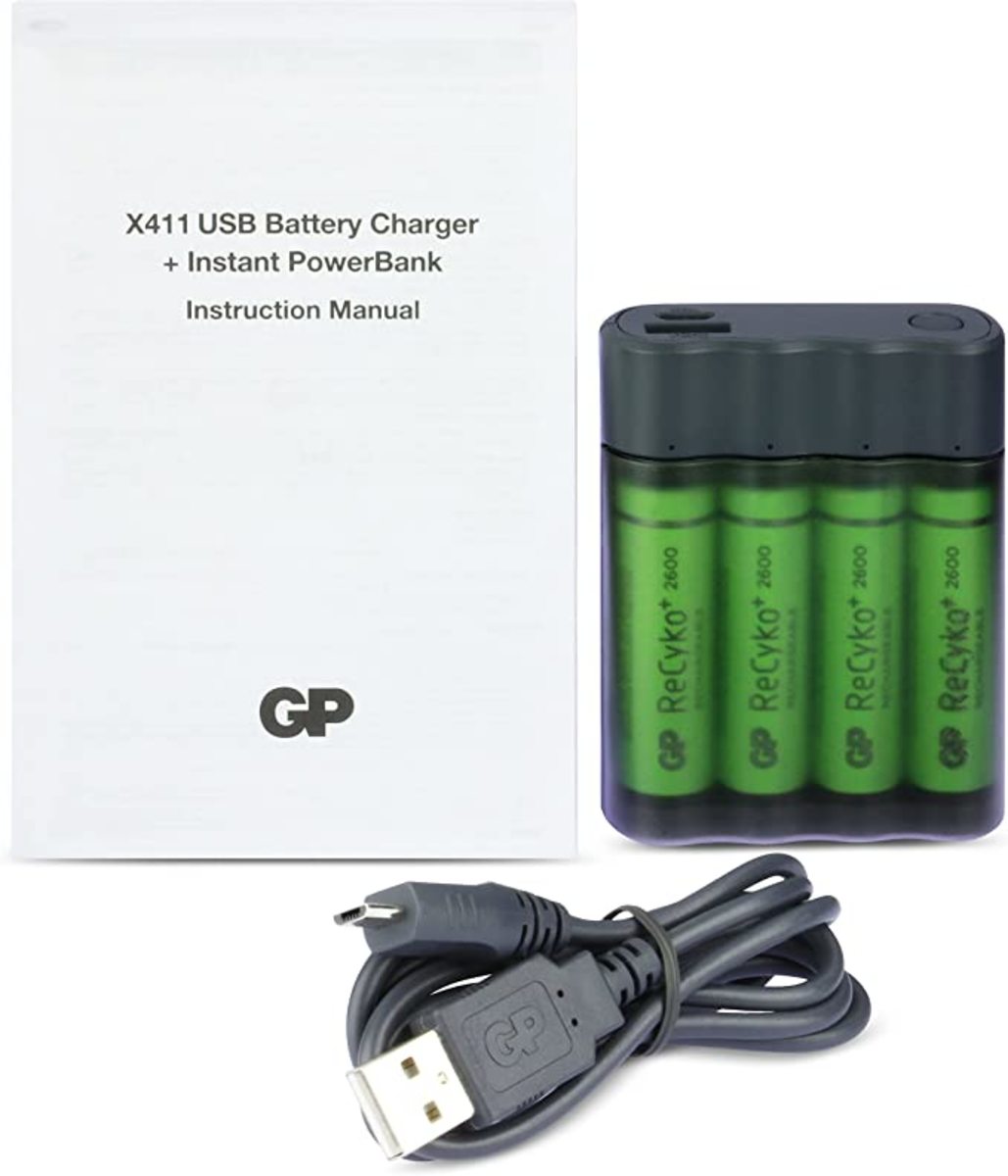So I took the time to go through my options, and decided to try out a battery charger that was also a power bank. When the batteries are charged, you can use the charger as a whole to charge your more modern USB-charged devices in a pinch, while sacrificing no shelf space charging your older devices.
GP Charge Anyway X411
GP Charge Anyway X411
My primary go-to is the GP Charge Anyway X411, which comes with four pre-charged NiMh AA batteries with 2600 mAh capacity. This can power an older walkman for a week, but the four of them together provide a little over ten thousand mAh, which is sufficient to keep a modern iPhone charged for a day and a half. Charging the device goes through a slightly old-fashioned micro-USB port, and it comes with a USB to micro-USB cable. This older model of port is the only downside to this article, if this had been USB-C it would have been perfect. The batteries charge relatively quick, at about four hours for a full charge on each slot. The slots charge independently, which means the charging will continue even if you remove a battery or two from the tray. The tray itself is of of thin but hard plastic, it is relatively fragile so I do not expect it to survive a lot of bumps. It’s clear that bringing this device with you should be considered an emergency move, it is not suited for EDC. The good
Can charge through USB meaning it accepts any USB-A ported adapted Charges four batteries at once, and independently Can be used as a power bank in emergencies Comes with four precharged AA batteries included
The bad
Fragile plastic housing limits longevity While it can hold larger batteries, it only charges at 500 mA per hour
The ugly
Micro-USB connector port makes finding replacement cables tricky Availability is limited in the United States
Panasonic BQ-CC75KSBHA Charger
Panasonic BQ-CC75KSBHA Charger
For those of you who live in the United States, the Panasonic BQ-CC75KSBHA might be a better option, as it features a USA AC wall plug in addition to the ability to charge the batteries through the USB port. However, even though both the USB port and the AC plug can charge it, it cannot charge the batteries and charge an attached USB device at the same time. So it can serve as a power bank, but not while charging batteries. The advantage to this model is that it features a USB-A port, which means it is easier to find a new cable and adapter for it if an accident happens. However, it is made of similar hard, fragile plastic as the GP Charge Anyway, so I would not recommend bringing it on everyday trips. It is also slower to charge, taking seven hours to charge each AA battery. However, it can also accept AAA batteries so it is much more versatile in that department. The good
Charges AA and AAA batteries Auto shut-off when batteries are full USB-A to USB-A connector Retractable AC plug
The bad
Does not come with any batteries Charges AA in 7 hours and AAA in 6 hours
The ugly
USA power plug limits international use
The Verdict
In the USA, I would definitely recommend the Panasonic charger, as it is much more versatile in what batteries it accepts and the format of its charging port. However, it is slower to charge the batteries and still cannot charge and discharge concurrently. If you are living in Europe, my recommendation would still be to go for the Panasonic, even though the plug likely will not help you as it is aimed at 110V instead of 220V - so do not plug it in without a converter! Although it is more expensive to ship and pay customs on it, and you will have to buy your own batteries, its versatility out-competes the GP. That said, buying international means you likely will have difficulties calling on warranty and right to return. If this is important to you, I would recommend sticking with the GP as the best option. This content is accurate and true to the best of the author’s knowledge and is not meant to substitute for formal and individualized advice from a qualified professional. © 2022 Lolcrow
